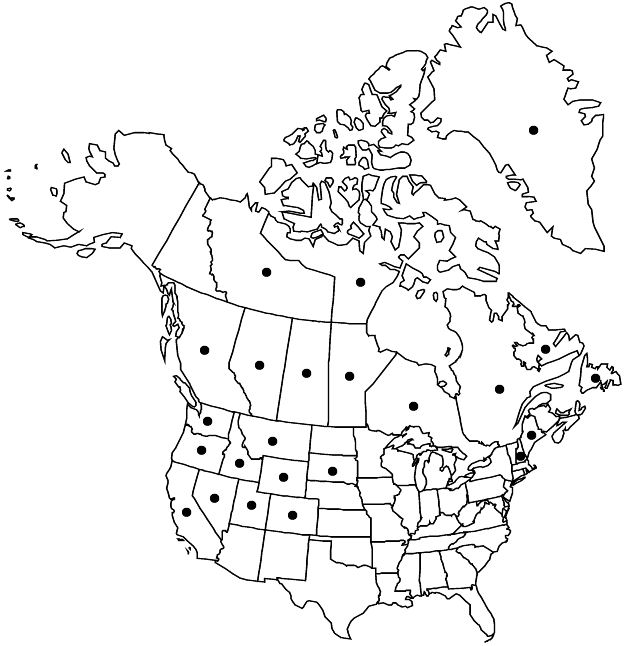Difference between revisions of "Viola palustris"
Sp. Pl. 2: 934. 1753.
FNA>Volume Importer |
imported>Volume Importer |
||
| (5 intermediate revisions by 2 users not shown) | |||
| Line 12: | Line 12: | ||
|name=Viola palustris subsp. brevipes | |name=Viola palustris subsp. brevipes | ||
|authority=M. S. Baker | |authority=M. S. Baker | ||
| + | |rank=subspecies | ||
}} {{Treatment/ID/Synonym | }} {{Treatment/ID/Synonym | ||
|name=V. palustris var. brevipes | |name=V. palustris var. brevipes | ||
|authority=(M. S. Baker) R. J. Davis | |authority=(M. S. Baker) R. J. Davis | ||
| + | |rank=variety | ||
}} {{Treatment/ID/Synonym | }} {{Treatment/ID/Synonym | ||
|name=V. palustris var. leimonia | |name=V. palustris var. leimonia | ||
|authority=J. K. Henry | |authority=J. K. Henry | ||
| + | |rank=variety | ||
}} {{Treatment/ID/Synonym | }} {{Treatment/ID/Synonym | ||
|name=V. palustris var. pensylvanica | |name=V. palustris var. pensylvanica | ||
|authority=Gingins | |authority=Gingins | ||
| + | |rank=variety | ||
}} {{Treatment/ID/Synonym | }} {{Treatment/ID/Synonym | ||
|name=V. palustris subsp. pubifolia | |name=V. palustris subsp. pubifolia | ||
|authority=Kuta | |authority=Kuta | ||
| + | |rank=subspecies | ||
}} | }} | ||
|hierarchy=Violaceae;Viola;Viola palustris | |hierarchy=Violaceae;Viola;Viola palustris | ||
| Line 53: | Line 58: | ||
-->{{#Taxon: | -->{{#Taxon: | ||
name=Viola palustris | name=Viola palustris | ||
| − | |||
|authority=Linnaeus | |authority=Linnaeus | ||
|rank=species | |rank=species | ||
| Line 68: | Line 72: | ||
|publication year=1753 | |publication year=1753 | ||
|special status= | |special status= | ||
| − | |source xml=https:// | + | |source xml=https://bitbucket.org/aafc-mbb/fna-data-curation/src/2e0870ddd59836b60bcf96646a41e87ea5a5943a/coarse_grained_fna_xml/V6/V6_246.xml |
|genus=Viola | |genus=Viola | ||
|species=Viola palustris | |species=Viola palustris | ||
Latest revision as of 22:20, 5 November 2020
Plants perennial, acaulescent, stoloniferous, 3–21.5 cm; stolons pale, often rooting and leafy at nodes; rhizome slender, fleshy. Leaves basal, 2–4, ascending to erect; stipules linear-lanceolate, margins entire, apex acute; petiole 1–17 cm, glabrous; blade unlobed, reniform or ovate to orbiculate, 0.5–6.4 × 0.5–5.5 cm, ± as long as wide, base cordate, margins crenulate, eciliate, apex obtuse to acuminate, surfaces glabrous. Peduncles 2–20.7 cm, glabrous, bracteoles usually below middle in chasmogamous flowers. Flowers: sepals ovate or lanceolate, margins eciliate, auricles 1–2 mm; petals lilac, pale blue, or pale violet on both surfaces, sometimes nearly white and tinged with lilac, lowest and sometimes lateral 2 dark violet-veined, lateral 2 bearded or beardless, lowest 8–16 mm, spur usually same color as petals, gibbous, 1–3 mm; style head beardless; cleistogamous flowers on ascending peduncles. Capsules ellipsoid, 6–10 mm, glabrous. Seeds dark brown, 1–2 mm. 2n = 48.
Phenology: Flowering Apr–Jul.
Habitat: Marshes, swamps, fens, wet forests, stream banks, brushy places, lowlands to subalpine zones
Elevation: 0–1800 m
Distribution

Greenland, Alta., B.C., Man., Nfld. and Labr., N.W.T., Nunavut, Ont., Que., Sask., Calif., Colo., Idaho, Maine, Mont., Nev., N.H., Oreg., S.Dak., Utah, Wash., Wyo., Eurasia.
Discussion
Viola palustris occurs in small colonies; individual plants are interconnected by stolons. When flowering, usually three or more leaves are present per caudex.
M. Sorsa (1968) noted that in western North America Viola palustris specimens differ from European V. palustris plants and often show variation in character combinations. She stated (pers. comm.) that North American V. palustris is not a uniform entity.
E. Hultén (1968) synonymized Viola palustris with V. epipsila, as did W. J. Cody (2000). G. W. Douglas et al. (1998–2002, vol. 5) recognized both species. We assume that V. palustris does not occur in Alaska; verification is needed. See additional discussion under 18a. V. epipsila var. repens.
M. Sorsa (1968) indicated that Viola palustris var. brevipes has often been confused with V. blanda and that var. brevipes may have arisen from hybridization between a tetraploid and a diploid plant. Listed here in synonymy, var. brevipes may warrant recognition.
Reports of Viola palustris from one location in Coconino County, Arizona, first collected in 1962, likely refer to V. macloskeyi.
Viola palustris hybridizes with V. epipsila var. repens (M. Sorsa 1968; T. Marcussen and T. Karlsson 2010).
Selected References
None.